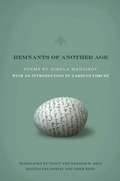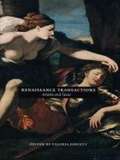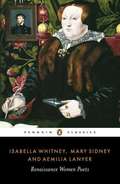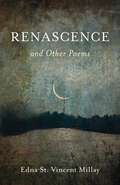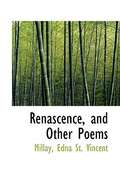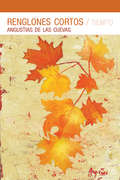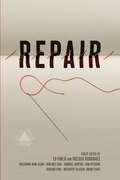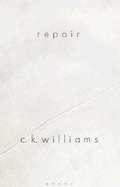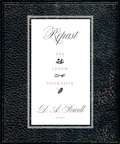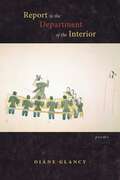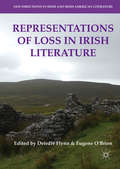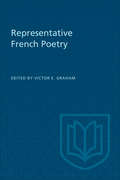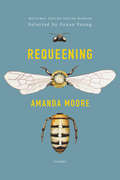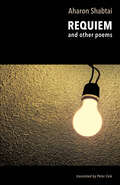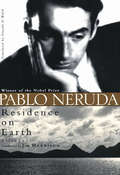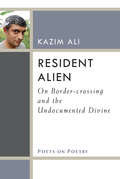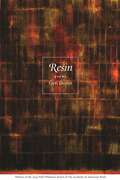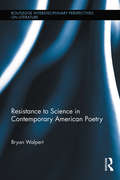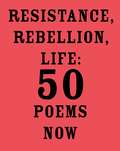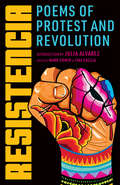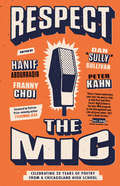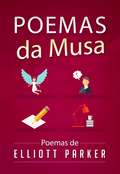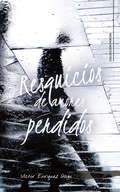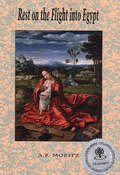- Table View
- List View
Remnants of Another Age (Lannan Translations Selection Series)
by Nikola Madzirov"These poems move mysteriously by means of a profound inner concentration, giving expression to the deepest laws of the mind. Their linguistic 'making' is informed by vivid evidence of a serious self-making, soul-making, and heart-making. We are lucky to have these English incarnations of Nikola Madzirov."-Li-Young LeeBorn 1973 in a family of Balkan Wars refugees, Nikola Madzirov's poetry has already been translated into thirty languages and published in collections and anthologies in the United States, Europe, and Asia. A regular participant in international literary festivals, he has received several international awards including an International Writing Program fellowship at the University of Iowa. Remnants of Another Age is his first full-length American collection and carries a foreword by Carolyn Forché who writes, "Nikola Madzirov's Remnants of Another Age is aptly titled, as these poems seem to spring from elsewhere in time, reflective of a preternaturally wise and attentive sensibility. As we read these poems, they begin to inhabit us, and we are the better for having opened ourselves to them. Madzirov is a rare soul and a true poet.""I SAW DREAMS"I saw dreams that no one remembersand people wailing at the wrong graves.I saw embraces in a falling airplaneand streets with open arteries.I saw volcanoes asleep longer thanthe roots of the family treeand a child who's not afraid of the rain.Only it was me no one saw,only it was me no one saw.
Renaissance Transactions: Ariosto and Tasso
by Valeria FinucciThe controversy generated in Italy by the writings of Ludovico Ariosto and Torquato Tasso during the sixteenth century was the first historically important debate on what constitutes modern literature. Applying current critical theories and tools, the essays in Renaissance Transactions reexamine these two provocative poet-thinkers, the debate they inspired, and the reasons why that debate remains relevant today. Resituating these writers' works in the context of the Renaissance while also offering appraisals of their uncanny "postmodernity," the contributors to this volume focus primarily on Ariosto's Orlando furioso and Tasso's Gerusalemme liberata. Essays center on questions of national and religious identity, performative representation, and the theatricality of literature. They also address subjects regarding genre and gender, social and legal anthropology, and reactionary versus revolutionary writing. Finally, they advance the historically significant debate about what constitutes modern literature by revisiting with new perspective questions first asked centuries ago: Did Ariosto invent a truly national, and uniquely Italian, literary genre--the chivalric romance? Or did Tasso alone, by equaling the epic standards of Homer and Virgil, make it possible for a literature written in Italian to attain the status of its classical Greek and Latin antecedents? Arguing that Ariosto and Tasso are still central to the debate on what constitutes modern narrative, this collection will be invaluable to scholars of Italian literature, literary history, critical theory, and the Renaissance.Contributors. Jo Ann Cavallo, Valeria Finucci, Katherine Hoffman, Daniel Javitch, Constance Jordan, Ronald L. Martinez, Eric Nicholson, Walter Stephens, Naomi Yavneh, Sergio Zatti
Renaissance Women Poets
by Danielle Clarke Isabella Whitney Mary Sidney Aemilia LanyerIncludes passages from 3 Renaissance women poets (RWP) who are strong and original voices which alter our picture of the golden age of English Lit. Social convention prevented RWP from openly taking part in the political and religious debates of their day, but they found varied and innovative ways of intervening indirectly. Whitney explored issues of sexual morality and her sense of exclusion from the greedy and commercial London of the 1570s. Sidney produced translations of Petrarch and the Psalms as well as original verse in order to mourn her late brother, develop his legacy and promote the Protestant cause. Lanyer wrote poetry which defends Eve's actions in the Garden of Eden, and celebrates female virtue and spirituality.
Renascence and Other Poems
by Edna St. MillayOften considered her best work, and one of the best-known American poems, the long poem "Renascence" is credited with introducing Edna St. Vincent Millay to a the broader world. Celebrated for their lyrical transcendence, Millay's poems convey fiery romance and an invigorating spirit that are hallmarks of her writing. Published as the inaugural title in Down East Books Maine Standards series, this volume brings the classic "Renascence" and two dozen other poems back to contemporary readers.
Renascence and Other Poems (Dover Thrift Editions)
by Edna St. MillayThe poems of Edna St. Vincent Millay (1892–1950) have been long admired for the lyric beauty that is especially characteristic of her early works. "Renascence," the first of her poems to bring her public acclaim, was written when she was nineteen. Now one of the best-known American poems, it is a fervent and moving account of spiritual rebirth.In 1917, "Renascence" was incorporated into her first volume of poetry, which is reprinted here, complete and unabridged, from the original edition. The 23 works in this first volume are fired with the romantic and independent spirit of youth that Edna St. Vincent Millay came to personify. In addition to "Renascence," this volume includes 16 other early lyric poems — "Interim," "Sorrow," "Ashes of Life," "Three Songs of Shattering," "The Dream," "When the Year Grows Old," and others, including six sonnets, to which Millay brought great distinction throughout her career.
Renascence, and Other Poems
by Edna St. Vincent MillayAs outspoken in his day as Richard Dawkins or Christopher Hitchens are today, American freethinker and author ROBERT GREEN INGERSOLL (1833-1899) was a notorious radical whose uncompromising views on religion and slavery (they were bad, in his opinion), women's suffrage (a good idea, he believed), and other contentious matters of his era made him a wildly popular orator and critic of 19th-century American culture and public life. As a speaker dedicated to expanding intellectual horizons and celebrating the value of skepticism, Ingersoll spoke frequently on such topics as atheism, freedom from the pressures of conformity, and the lives of philosophers who espoused such concepts. This collection of his most famous speeches includes the lectures: [ "The Gods" (1872) [ "Humboldt" (1869) [ "Thomas Paine" (1870) [ "Individuality" (1873) [ "Heretics and Heresies" (1874)
Renglones cortos: Tiempo
by Angustias de las Cuevas«Un canto a la nostalgia por lo que pudo ser y se quedó en simples sueños, la idealización por lo que puede llegar a ser, el inconformismo ante la pérdida de los sentimientos románticos. Esa postura en la que se encuentran todos los que están situados en la curva de la existencia justo cuando comienza el descenso.» Renglones cortos está compuesto por cincuenta y dos poemas, donde el tiempo marca las directrices en su desarrollo. Estos renglones cortos nacen de una forma espontánea, guiados por los sentimientos más básicos del ser humano, la de vivir no solo existiendo, sino sintiendo en cada entresijo del alma. Y se consiguen a través de un lenguaje descifrable, donde la figura retórica de la perífrasis se hace evidente, como fórmula para estimular el pensamiento y lograr idealizarlo a través de un conjunto de palabras necesarias para designar unos sentimientos. En definitiva se trata de emocionar a través de las palabras, de sentir a través de ellas, de reflexionar ante el factor determinante que es el transcurrir el tiempo. «Siempre en un inmenso placer leerte, termino cada lectura y en mi mente corren manantiales y brisas de tiempos que no volverán, pero esta estrofa me mata y me transforma:¡Déjenme llorar mis sueños! ¡Déjeme consumir mis restos en el viejo hontanar de mis recuerdos! ¡Déjeme descansar a solas! Porque son otros tientos ahora los que rescataran mis cenizas!!!...»Enrique Caldas
Repair (Boston Review / Forum)
by Ed Pavlić Ivelisse RodriguezHow we can recover from terrible ruptures, the pandemic, toxic politics, racist horrors, class warfare, gendered violence, and ecological brinksmanship.Individually and collectively, we bear deep wounds. Some of these are generations old; all have been worsened by a destructive period of pyrrhic politics that left us ill-equipped to respond to a global health catastrophe. As we struggle to recover our footing and grieve our dead, Boston Review believes that the arts must have a voice in the conversation about how we heal. In this new anthology of poetry, fiction, and essays from renowned writers and newcomers, writers explore whether and how we can repair terrible ruptures, life-threatening illnesses and the pandemic, toxic politics, racist horrors, class warfare, gendered violence, and ecological brinksmanship. ContributorsAriella Aisha Azoulay, Kemi Alabi, Donia Elizabeth Allen, Don Mee Choi, Adebe DeRango-Adem, Emma Dries, Farah Jasmine Griffin, Randall Horton, Savonna Johnson, Kim Hyesoon, Maya Marshall, Colleen Murphy, Simone Person, aureleo sans, Bishakh Som, Olúfmi O. Táíwò, Meredith Talusan, Brian Teare, Yiru Zhang
Repair: Poems
by C. K. WilliamsRepair is body work in C. K. Williams's sensual poems, but it is also an imaginative treatment of the consternations that interrupt life's easy narrative. National Book Critics Circle Award-winner Williams keeps the self in repair despite love, death, social disorder, and the secrets that separate and join intimates. These forty poems experiment with form but maintain what Alan Williamson has heralded Williams for having so steadily developed from French influences: "the poetry of the sentence".<P><P> Pulitzer Prize Winner
Repast: Tea, Lunch, and Cocktails
by D. A. PowellD. A. Powell's first three groundbreaking booksPublished together for the first time, D. A. Powell's landmark trilogy of Tea, Lunch, and Cocktails make up a three-course Divine Comedy for our day. With a new introduction by novelist David Leavitt, Repast presents a major achievement in contemporary poetry.
Report to the Department of the Interior: Poems (Mary Burritt Christiansen Poetry Series)
by Diane GlancyConstructed as a series of reports to the Department of the Interior, these poems of grief, anger, defiance, and resistance focus on the oppressive educational system adopted by Indian boarding schools and the struggle Native Americans experienced to retain and honor traditional ways of life and culture.
Representations of Loss in Irish Literature (New Directions in Irish and Irish American Literature)
by Eugene O'Brien Deirdre FlynnThis is the first book on Irish literature to focus on the theme of loss, and how it is represented in Irish writing. It focuses on how literature is ideally suited to expressions and understanding of the nature of loss, given its ability to access and express emotions, sensations, feelings, and the visceral and haptic areas of experience. Dealing with feelings and with sensations, poems, novels and drama can allow for cathartic expressions of these emotions, as well as for a fuller understanding of what is involved in loss across all situations. The main notion of loss being dealt with is that of death, but feelings of loss in the wake of immigration and of the loss of certainties that defined notions of identity are also analysed. This volume will be of interest to scholars, students and researchers in Irish Studies, loss, memory, trauma, death, and cultural studies.
Representative French Poetry (Second Edition)
by Victor E GrahamThe making of a reasonably comprehensive anthology which is intended to do more than reflect the personal literary tastes of the anthologists is not an easy task, but is certainly an exciting and challenging one. It is important, of course, if it is to have coherence and validity, that its audience be reasonably well defined and kept in mind as the selection proceeds. The anthology offered by Professor Graham has been prepared carefully to meet the needs of students reading French poetry while in the early years of their university course. It does not attempt to be a bulky sample of the whole field of French poetry but rather to be a judicious selection of the works of poets who may be described as typical of the best in their age. From each of them have been included some well-known selections which students must always meet and also some less well known which are nevertheless equal in quality and whose relative unfamiliarity may give them a special appeal to instructors. A particularly interesting and valuable feature of the anthology is that the editor has in a good many cases chosen poems on similar themes from different authors, and students will thus be able to compare styles of different centuries and different poets as applied to certain specific subjects. (For example, the selection includes Deschamps' "Balade" on "Renart et le Corbaut" and La Fontaine's "Le Corbeau et le Renard'; Lamartine's and also Leconte de Lisle's "Le Lac.")
Requeening: Poems
by Amanda MooreA collection of poetry from the 2020 winner of the National Poetry Series, selected by Ocean VuongEngaging the matriarchal structure of the beehive, Amanda Moore explores the various roles a woman plays in the family, the home, and the world at large. Beyond the productivity and excess, the sweetness and sting, Requeening brings together poems of motherhood and daughterhood, an evolving relationship of care and tending, responsibility and joy, dependence and deep love.The poems that anchor this collection don’t shy away from the inevitability of a hive’s collapse and consider the succession of “requeening” a hive as “a new heart ready to be fed and broken and fed again.” The collapse is both physical—there are poems of illness and recovery—and emotional, as the mother-daughter relationship shifts, the daughter becoming separate, whole, and poised to displace. The liminal spaces these poems traverse in human relationships is echoed in a range of poetic and hybrid form, offering freedom and stricture as they contemplate the way we hold one another in love and grief.Requeening is a vivid and surprising collection of poems from a winner of the National Poetry Series Open Competition.
Requiem: & Other Poems
by Aharon ShabtaiPart kaddish, part lament, and a powerful call for peace, Requiem and Other Poems cries out for an end to unspeakable violence Part kaddish, part lament, and a powerful call for stocktaking and peace, Requiem cries out for an end to carnage and slaughter: "The horror / the calamity / the disgrace, / the rubble of folly / and religion's stupidities, / the dimness of vision / and violence of despair / won't be repaired by an officer, / a bomb or a plane, / and not by still more blood. / Only wisdom of the heart could mend it... / only the gardeners of peace."Long one of the most outspoken Israeli critics of his government's treatment of the Palestinians, Aharon Shabtai is widely viewed as "the most important Hebrew poet of his generation" (The Boston Globe).
Residence on Earth
by Pablo Neruda Jim Harrison Donald D. WalshNew Directions celebrates the Pablo Neruda Centennial. In celebration of the 100th anniversary of Pablo Neruda's birth, New Directions is pleased to announce the reissue of a classic work in a timeless translation by Donald D. Walsh and fully bilingual. Residence on Earth is perhaps Neruda's greatest work. Upon its publication in 1973, this bilingual publication instantly became "a revolution... a classic by which masterpieces are judged" (Review). "In Residence on Earth," wrote Amado Alonso, "the tornado of fury will no longer pass without lingering, because it will be identified with [Neruda's] heart."
Resident Alien: On Border-crossing And The Undocumented Divine
by Mohammed Kazim AliKazim Ali uses a range of subjects--the politics of checkpoints at international borders; difficulties in translation; collaborations between poets and choreographers; and connections between poetry and landscape, or between biotechnology and the human body--to situate the individual human body into a larger global context, with all of its political and social implications. He finds in the quality of ecstatic utterance his passport to regions where reason and logic fail and the only knowledge is instinctual, in physical existence and breath. This collection includes Ali's essays on topics such as Anne Carson's translations of Euripides; the poetry and politics of Mahmoud Darwish; Josey Foo's poetry/dance collaborations with choreographer Leah Stein; Olga Broumas' collaboration with T. Begley; Jorie Graham's complication of Kenneth Goldsmith's theories; the postmodern spirituality of the 14th century Kashmiri mystic poet Lalla; translations of Homer, Mandelstam, Sappho, and Hafez; as well as the poet Reetika Vazirani's practice of yoga. "Ali has a vibrant and generous personality that lets one hear the inner music that makes us remember what it is to be human. " --Painted Bride Quarterly
Resin: Poems (Walt Whitman Award of the Academy of American Poets)
by Geri DoranIn poems of quiet force, Geri Doran maps the fragility of human connection and the irreducible fact of grief. From the communal ruptures of Chechnya and Rwanda to the personal dislocations that attend great loss, Resin weighs frailty against responsibility, damage against the desires of the heart. For the poet, a factory fire in late-nineteenth-century Portland becomes a tool for precise knowing: "The phases of wood are a means / of dead reckoning: burn what is built / and gauge your passage / by what is lost." Even in so quotidian an act as the planting of potatoes, Doran's sure, meticulous, and carefully calibrated lines reveal the intensity of our yearnings: "What carried us from year to year was yield: / potatoes in, potatoes out, like rowing." Variously plaintive, passionate, intuitive, and serious, the voice in Resin tells how the natural world, in both its wildness and regularity, expresses and mediates human longing.You entered me like migraine, leftlike migraine a private vacancy.The darkness outside is great and wild.Blue plums falling from an old treedemand we believe in wildness,fallingness. What's the matter is memory,shrivel and tart. How in this sweetaftermath of everything the mindshould settle on plums (blue plums!)is one of the mysteries. That Godand my window-blinds should conspireto refract the light to look like plums.Out in the wild nothing. -- from "Blue Plums"
Resistance to Science in Contemporary American Poetry (Routledge Interdisciplinary Perspectives on Literature)
by Bryan WalpertThis book examines types of resistance in contemporary poetry to the authority of scientific knowledge, tracing the source of these resistances to both their literary precedents and the scientific zeitgeists that helped to produce them. Walpert argues that contemporary poetry offers a palimpsest of resistance, using as case studies the poets Alison Hawthorne Deming, Pattiann Rogers, Albert Goldbarth, and Joan Retallack to trace the recapitulation of romantic arguments (inherited from Keats, Shelly, and Coleridge, which in turn were produced in part in response to Newtonian physics), modernist arguments (inherited from Eliot and Pound, arguments influenced in part by relativity and quantum theory), and postmodernist arguments (arguments informed by post-structuralist theory, e.g. Barthes, Derrida, Foucault, with affinities to arguments for the limitations of science in the philosophy, sociology, and rhetoric of science). Some of these poems reveal the discursive ideologies of scientific language—reveal, in other words, the performativity of scientific language. In doing so, these poems themselves can also be read as performative acts and, therefore, as forms of intervention rather than representation. Reading Retallack alongside science studies scholar Karen Barad, the book concludes by proposing that viewing knowledge as a form of intervention, rather than representation, offers a bridge between contemporary poetry and science.
Resistance, Rebellion, Life: 50 Poems Now
by Amit MajmudarPoets on the march: 50 crucial poems written in response to the current political climate, selected and introduced by the Ohio Poet Laureate—and son of immigrants—Amit Majmudar. In a political atmosphere where language and even meaning itself are continually under threat, poetry has a critical role to play. And our poets have been responding—in the streets and at their desks, demanding a full accounting from themselves and from their nation. Majmudar's elegant introduction to these vital poems reminds us that "false stories take a lot of killing because they are made of language. Because they are made of language, though, they can be killed." From Solmaz Sharif and Eileen Myles to Kevin Young and Juan Felipe Herrera, American poets of diverse styles and strategies have contributed their truths: scenes from the front lines of resistance, and from the interior of our collective conscience. A final cento by Majmudar—a poem including at least one line or phrase from each of the poems in the volume—celebrates the robust multiplicity of voices in this book and in America now.
Resistencia: Poems of Protest and Revolution
by Mark Eisner and Tina Escaja“To read these poems is to be reminded again and again of our true allegiance to each other.” —from the introduction by Julia Alvarez With a powerful and poignant introduction from Julia Alvarez, Resistencia: Poems of Protest and Revolution is an extraordinary collection, rooted in a strong tradition of protest poetry and voiced by icons of the movement and some of the most exciting writers today. The poets of Resistencia explore feminist, queer, Indigenous, and ecological themes alongside historically prominent protests against imperialism, dictatorships, and economic inequality. Within this momentous collection, poets representing every Latin American country grapple with identity, place, and belonging, resisting easy definitions to render a nuanced and complex portrait of language in rebellion. Included in English translation alongside their original language, the fifty-four poems in Resistencia are a testament to the art of translation as much as the act of resistance. An all-star team of translators, including former US Poet Laureate Juan Felipe Herrera along with young, emerging talent, have made many of the poems available for the first time to an English-speaking audience. Urgent, timely, and absolutely essential, these poems inspire us all to embrace our most fearless selves and unite against all forms of tyranny and oppression.
Respect the Mic: Celebrating 20 Years of Poetry from a Chicagoland High School
by Tyehimba Jess Franny Choi Hanif Abdurraqib Peter Kahn Dan Sully" SullivanAn expansive, moving poetry anthology, representing 20 years of poetry from students and alumni of Chicago's Oak Park River Forest High School Spoken Word Club."Poets I know sometimes joke that the poetry club at Oak Park River Forest High School is the best MFA program in the Chicagoland area. Like all great jokes, this one is dead serious." -Eve L. Ewing, award-winning poet, playwright, scholar, and sociologist For Chicago's Oak Park and River Forest High School's Spoken Word Club, there is one phrase that reigns supreme: Respect the Mic. It's been the club's call to arms since its inception in 1999. As its founder Peter Kahn says, "It's a call of pride and history and tradition and hope." This vivid new collection of poetry and prose -- curated by award-winning and bestselling poets Hanif Abdurraqib, Franny Choi, Peter Kahn, and Dan "Sully" Sullivan -- illuminates just that, uplifting the incredible legacy this community has cultivated. Among the dozens of current students and alumni, Respect the Mic features work by NBA champion Iman Shumpert, National Youth Poet Laureate Kara Jackson, National Youth Poet Laureate Kara Jackson, National Student Poet Natalie Richardson, comedian Langston Kerman, and more.In its pages, you hear the sprawling echoes of students, siblings, lovers, new parents, athletes, entertainers, scientists, and more --all sharing a deep appreciation for the power of storytelling. A celebration of the past, a balm for the present, and a blueprint for the future, Respect the Mic offers a tender, intimate portrait of American life, and conveys how in a world increasingly defined by separation, poetry has the capacity to bind us together.
Resposta Da Musa: Poemas De Michael La Ronn
by Michael La Ronn Mafalda PintoNesta imaginativa coleção de poemas, Michael La Ronn obedece à sua musa e cria coloridas experiências de admirável delicadeza. São destemidos, nada deixam por explorar e não desperdiçam palavras. Esta diversificada coleção está ao nível das obras em prosa de La Ronn, distinguindo-o como um importante poeta da geração do milénio. CONVOCADOS Que luz é esta, que enche o céu suburbano? O que é este verde cintilante que faz a cintura de Órion brilhar num fogo rápido? Porque desce como neblina etérea, roçando as telhas das casas, transformando as janelas em microcosmos esmeralda? Tu não sabes, mas assim que desça sobre ti, vão soltar-se pequenas bolas, a vizinhança vai dançar, cadeados brilhantes vão abrir-se e surpreender toda a gente que dorme. Não sabes porquê, mas sabe bem enquanto pequenos dedos de luz te levantam do chão, te exaltam em direção a uma espiral lenta, nas estrelas. Transbordas de êxtase e dizes finalmente, vieste à colónia de olhos que se juntou à volta da mesa de operações onde foste colocado.
Resquicios de amores perdidos
by Víctor Enríquez Gago¿Necesitas frases bonitas para tus redes sociales? ¡Aquí puedes encontrarlas! Aunque no seas un gran amante de los libros o de la lectura, esta obra puede interesarte. Este librito va dirigido para todas aquellas personas que en algún momento de su vida han sentido y sufrido por amor. Estas poesías pretenden emocionarte y llamar a tus recuerdos. Sentir sea lo que sea nos mantiene vivos.
Rest on the Flight into Egypt
by A. F. MoritzShortlisted for the 2000 Governor General's Award for Poetry From the outskirts of the fevered empire, and the embers that were its heart, Moritz sings us to our selves -- our failures, our cruelties, our stupidities, and beauty which even now astonishes and leaves us breathless. Genuine political poetry is immensely difficult. Moritz succeeds, not because his list of atrocities is longer or more shocking, but because his vision is underwritten -- not whitewashed – by an ecstatic lyricism that knows evanescence is the only enduring truth.
